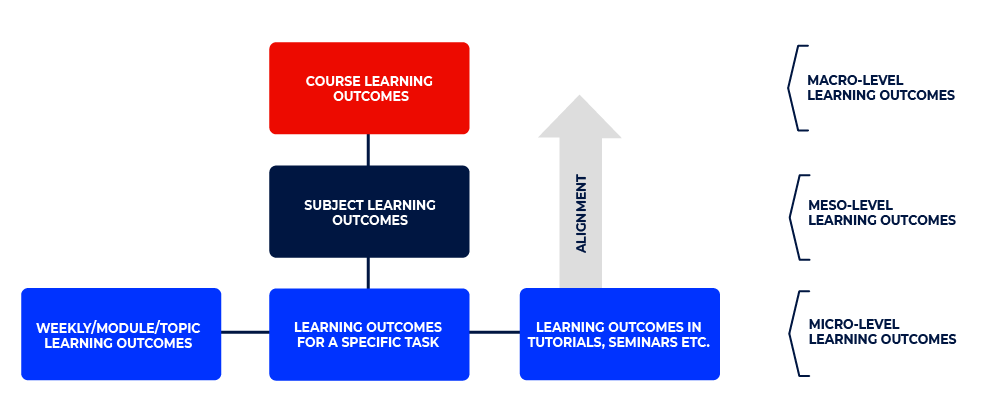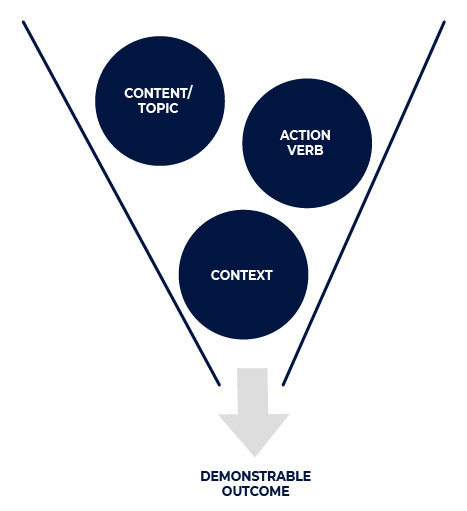Writing learning outcomes
Learning outcomes are clear and specific statements that identify what learners must demonstrate and to what degree by the end of a learning event. For learners, learning outcomes explicitly state for what they are responsible as part of a learning event and they define the level at which they are expected to perform. For subject matter experts and learning designers, learning outcomes are a useful tool to define the scope of your learning event and to guide the design of materials and experiences that support learners in achieving the outcomes.
Learning outcomes can be applied to any learning event or experience, whether it be a course, subject, online module, a tutorial or lecture. Furthermore, learning outcomes can be defined at different levels - macro, meso and micro (cf. Figure 1) - and aligned across levels. A learning outcome at the macro level can be broken down into smaller learning outcomes at the meso level, and those learning outcomes can be further broken down at the micro level. For example, a learning outcome can be defined for a course and perhaps broken down into a couple of subject learning outcomes, which could then be broken now still further into a set of outcomes for an online module.

Figure 1. Learning outcomes at macro-, meso-, and micro levels.
Meso-level learning outcomes: Subject learning outcomes
Micro-level learning outcomes: Weekly/module/topic learning outcomes, Learning outcomes for a specific task, learning outcomes for tutorials/seminars/etc.
Micro, Meso and Macro-level learning outcomes are in alignment.
Regardless of where they are applied, learning outcomes define what learners will be able to do at the end of a learning event. Constructively aligned with activities and assessments, learning activities can help subject matter experts and learning designers make judicious decisions about concepts, content and formative and summative assessment activities, thus eliminating extraneous information and preventing cognitive overload.
Why?
Learning outcomes define what learners will know and be able to do at the end of a learning experience (e.g., subject or course). Good learning outcomes assist you in designing learning events to define the scope and level of the learning activities and the means by which to assess learning. For learners, well-written learning outcomes provide a guide for what they should be able to do and what they can expect from a learning event.
How?
Writing effective learning outcomes involves consideration of several factors. The Australian Qualifications Framework (AQF) recommends a useful way of categorising learning outcomes as you develop them. Consider whether your outcome is asking students to:
- talk about the knowledge they have gained,
- demonstrate the skills they have learned, or
- apply both knowledge and skills to a task.

Figure 2. Components of a learning outcome: Action verb, content/topic, and the context
Once you have determined to which of these categories your outcome( s) belong (i.e., what are you teaching), you can begin writing them.
A learning outcome typically identifies and action, who will perform that action and under what conditions. Put another way, you can think of the ABC’s of learning outcomes: Audience, Behaviour, Condition. Take the following example:

Figure 3: ABC's of Learning Outcomes
Condition: By the completion of this course
Audience: the learner
Behaviour: write effective learning outcomes.
In the example above, our audience is “the learner”. The behaviour tells us the action the learners are to perform, which is “to write effective learning outcomes.” Lastly, the condition states the circumstances within which the learner will demonstrate the behaviour—"by the completion of the course.”
Making learning outcomes measurable
In addition to the components of learning outcomes described previously, they also need to be measurable. In other words, learning outcomes indicate an expected behaviour or activity performed by a learner that demonstrates an outcome (e.g., degree of learning). The following is an example of a measurable outcome:
In the above example, we know what the outcome is - “to articulate the difference between measurable and non-measurable outcomes.” We can measure this articulation through, perhaps, a presentation, a discussion post, a blog, or a short recitation.
By contrast, consider the following example:
This is an example of a non-measurable outcome. “Understanding” is a process internal to the learner. By itself, we wouldn’t necessarily be able to measure understanding. However, we can measure the result of that understanding through a behaviour in which the learner demonstrates that understanding. For example, the learner may “describe the difference…” or “outline the difference…”, which would be measurable actions.
To assist with writing measurable learning outcomes, Bloom’s Taxonomy of the Cognitive Domain is a useful tool. The taxonomy is divided into six levels from least to most complex (Remembering, Understanding, Applying, Analysing, Evaluating, and Creating). Each level of the taxonomy includes measurable verbs appropriate to that level. While the cognitive domain is the most popular of the taxonomies, Bloom also developed similar taxonomies for the affective and psychomotor domains, which are also included in the link above. These may be appropriate for learning experiences that explore emotions and feelings or movement and performance.
Components of effective learning outcomes
Well-written learning outcomes are:
- a statement of what the learner will do.
- achievable within the period allotted for the learning event (e.g., At the end of this unit you will…).
- phrased using a single measurable verb.
- written for appropriate cognitive, affective or psychomotor levels and, where required, are accurately aligned to appropriate levels of the Australian Qualifications Framework (AQF).
Related information
- Centre for the Advancement of Learning. (21 September 2018). Goals, objectives and outcomes [Video]. YouTube. https://youtu.be/hWMtqEe8Bs0
- Popenici, S. & Millar, V. (2015). Writing learning outcomes: A practical guide for academics. Melbourne Centre for the Study of Higher Education, The University of Melbourne. https://melbourne-cshe.unimelb.edu.au/__data/assets/pdf_file/0007/2296861/MCSHE-Learning-Outcomes-Guide-web-Nov2015-rev2021.pdf
References
Australian Qualifications Framework. (n.d.). Australian Qualifications Framework https://www.aqf.edu.au/ (Includes downloadable booklet of current AQF Framework)
Harvard University (n.d.). Taxonomies of learning. The Derek Bok Center for Teaching and Learning, Harvard University. https://bokcenter.harvard.edu/taxonomies-learning



